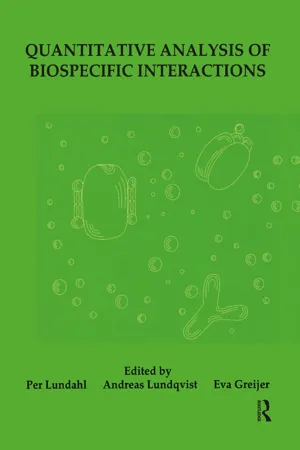
Quantitive Analysis Of Biospec
Per Lundahl,Andreas Lundqvist,Eva Greijer
- 244 Seiten
- English
- ePUB (handyfreundlich)
- Über iOS und Android verfügbar
Quantitive Analysis Of Biospec
Per Lundahl,Andreas Lundqvist,Eva Greijer
Über dieses Buch
First published in 2004, this book collects several up-to-date methods for quantitative analysis of biospecific interactions, a field that has a long history that perhaps can be said to have begun with the classical paper of G. Scatchard in 1949 (The attractions of proteins for small molecules and ions, but which has advanced impressively during the last few years. A precise spatial arrangement of just a few hydrogen bonds can confer a remarkably specific reversible association between two molecules. A web of weak interactions governs biospecific recognition in general. The binding equilibria in living cells tune and coordinate a multitude of functions. The thermodynamic properties of such interactions are often studied by binding experiments in simplified and essentially ideal systems. However, similar types of studies may elucidate the biologically relevant dynamic steady-state conditions in living cells and organisms, allowing for the very wide range of interactant concentrations and the interplay between the many reactions and interactions. The development in biosciences will continue with in-depth studies of macromolecules and membranes. More detailed knowledge will allow analyses of delicate balances between substances and events in the complex systems involved in life processes. Methods to study biospecific affinities are thus highly important tools for understanding mechanisms and effects of molecular binding events in vivo and in vitro, e.g., in biochemical, biomedical and pharmaceutical research, and for biotechnological research and production.
Häufig gestellte Fragen
Information
1. ELECTROPHORETIC ANALYSIS OF REVERSIBLE INTERACTIONS
NIELS H.H. HEEGAARD
INTRODUCTION
BACKGROUND AND THEORY
History
Theory of adsorption in chromatography | Wilson, 1940; Weiss, 1943; DeVault, 1943 |
Electrophoresis in gel supports | Smithies, 1955; Raymond and Weintraub, 1959; Hjertén, 1961 |
Biospecific interaction in electrophoresis | Nakamura and Ueta, 1958; Grabar and Williams, 1953; Macheboeuf et al., 1953 |
Theory of electrophoretic mobility shift analysis | Nakamura and Wakeyama, 1961 |
Quantitative estimates by affinity gel electrophoresis | Takeo and Nakamura, 1972; Bøg-Hansen and Takeo, 1980 |
Modern capillary electrophoresis | Mikkers et al., 1979; Jorgenson and Lukacs, 1981; 1983 |
Quantitative studies of binding in capillary electrophoresis | Heegaard and Robey, 1992; Kraak et al., 1992; Chu and Whitesides, 1992; Chu et al., 1992; Honda et al., 1992; Carpenter et al., 1992 |
Theory
Inhaltsverzeichnis
- Cover
- Half Title
- Title Page
- Copyright Page
- Table of Contents
- Preface
- Contributors
- 1 Electrophoretic Analysis of Reversible Interactions
- 2 Determination of Affinity Constants by Capillary Electrophoresis
- 3 Measurement of Binding Constants by Frontal Affinity Chromatography
- 4 Determination of Affinity Constants by Partition Equilibrium Methods
- 5 Determination of Transmembrane Protein Affinities for Solutes by Frontal Chromatography
- 6 Modeling of Chiral Liquid Chromatography using an Immobilized Protein as the Selector
- 7 Determination of Receptor-Ligand Affinity Constants
- 8 Determination of Equilibrium and Kinetic Constants for the Interaction of GTPases with Nucleotides, Regulators and Effectors
- 9 Biospecific Interaction Analysis using Integrated Optics Techniques
- 10 Receptor Binding Studies on Lipid Vesicles using the BIAcore
- 11 The Analysis of Surface Plasmon Resonance-based Biosensor Data using Numerical Integration: The Epidermal Growth Factor Receptor-Ligand Interaction as an Example
- 12 Affinity Chromatography for the Determination of Interactions between Drugs and Proteins: HPLC and CE Methods Employing ‘Secondary and Dynamic’ Equilibria
- Index